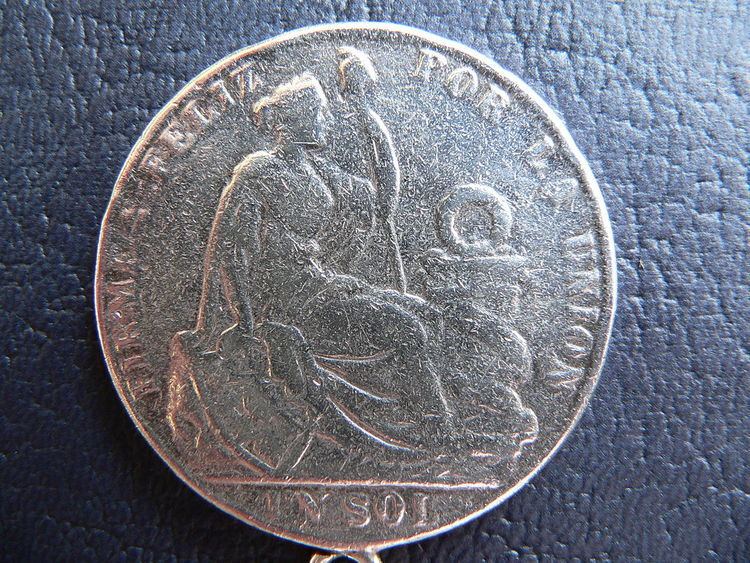20 soles banknote obverse 1 sol coin reverse Number 604 | Code PES ⁄10 dinero Plural soles | |
 | ||
The sol was the currency of Peru between 1863 and 1985. It had the ISO 4217 currency code PES. It was subdivided into 10 dineros or 100 centavos.
Contents
History
The sol was introduced in 1863 when Peru completed its decimalization, replacing the real at a rate of 1 sol = 10 reales. The sol also replaced the Bolivian peso, which had circulated in southern Peru, at the rate of 1 sol = 1.25 Bolivian pesos. Between 1858 and 1863, coins had been issued denominated in reales, centavos and escudos. The sol was initially pegged to the French franc at a rate of 1 sol = 5 francs (5.25 soles to the British pound and 1.08 soles to the US dollar).
In 1880 and 1881, silver coins denominated in pesetas, were issued, worth 20 centavos to the peseta. In 1881, the inca, worth ten soles, was introduced for use on banknotes. The peg to the franc was replaced in 1901 by a link to sterling at a rate of 10 soles = 1 pound, with gold coins and banknotes issued denominated in libra. This peg was maintained until 1930 when Peru left the gold standard and established an official rate of 2.5 soles = 1 USD, a rate which remained until 1946. In 1933, banknotes were issued once more denominated in soles, now called soles de oro. This name also appeared from 1935 on coins, when silver was replaced by base metal.
Since 1975, multiple rates to the U.S. dollar have been used.
Due to the chronic inflation that occurred in Peru during the second presidency of Fernando Belaúnde Terry, the sol was replaced in 1985 by the inti at a rate of 1000 soles = 1 inti. The nuevo sol replaced the inti in 1991, during the administration of Alberto Fujimori, at the rate of 1 million to one (or 1 billion (109) old sols to 1 nuevo sol).
Coins
In 1863, cupro-nickel coins for 1 and 2 centavos and .900 silver coins for ½ and 1 dinero and 1⁄5 sol were introduced, followed by .900 silver ½ and 1 sol in 1864. Gold 5, 10 and 20 soles were issued only in 1863. In 1875 and 1876, bronze replaced cupro-nickel. In 1879 and 1880, provisional coins were struck in cupro-nickel in denominations of 5, 10 and 20 centavos for replacing the banknotes with coins. In 1898, gold coins for 1 libra (10 soles) were introduced, followed by ½ libra (5 soles) in 1902 and 1⁄5 libra (or 2 soles) in 1905. These were issued for circulation until 1930.
In 1918, cupro-nickel 5, 10 and 20 centavos coins were introduced, followed, in 1922 with ½ and 1 sol coins in .500 fineness silver. The silver ½ and 1 sol were replaced by brass coins in 1935. Brass 5, 10 and 20 centavos followed in 1942. In 1950, zinc 1 and 2 centavos coins were introduced which were issued until 1958. In 1965, 25 centavos coins were introduced, followed, in 1969, by cupro-nickel 5 and 10 soles.
Production of 5 and 25 centavos ceased in 1975, followed by 10 and 20 centavos in 1976, and 50 centavos in 1977. In 1978, brass replaced cupro-nickel in the 5 and 10 soles whilst aluminium-bronze 50 soles and cupro-nickel 100 soles coins were introduced in 1979 and 1980. The last 1 and 5 soles coins were issued in 1982 and 1983. In 1984, brass 10, 50, 100 and 500 soles coins were issued. The last of these pieces was minted in 1985.
